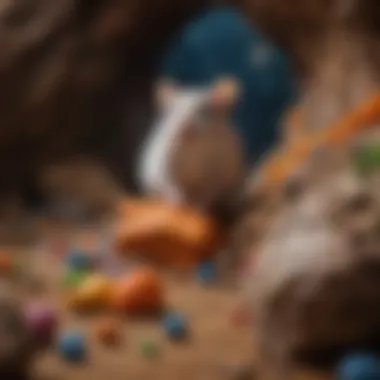Climbing Toys for Rats: Enhance Their Enrichment & Health


Intro
Climbing toys are not just amusing additions to a rat's cage; they play a critical role in the overall well-being of these intelligent creatures. Understanding the significance of climbing toys is essential for pet owners who aim to provide an enriched environment for their domesticated rats. Not only do climbing toys support physical health, but they also stimulate mental engagement and offer opportunities for natural behaviors.
This article will delve into the various facets of climbing toys for rats, such as their benefits for physical activity and behavioral enrichment. Furthermore, we will explore the different types of climbing structures available, discuss their construction materials, and analyze how the design impacts rat behavior. In addition, we will review how climbing aligns with the natural instincts of rats and provide guidelines on how to safely introduce climbing toys into your pet’s habitat.
Understanding Your Pet
Gaining a deeper understanding of your pet's needs and behaviors is the first step in enhancing their quality of life. By recognizing the distinct characteristics of domesticated rats, you can make informed decisions about their environment, diet, and enrichment activities.
Pet Behavior Basics
Rats are naturally curious and active animals. They enjoy exploring their surroundings, climbing, and tunneling. Engaging in these activities is vital for their mental stimulation and physical fitness. Without adequate opportunities for exercise and exploration, rats can become bored, leading to stress or behavioral issues.
Common Breed Characteristics
While domesticated rats may share common traits, specific breeds have distinct behaviors. For instance, Rex rats have softer fur and are known for their friendly nature. Standard rats often exhibit high levels of curiosity and intelligence. Understanding these characteristics helps in choosing appropriate climbing toys that cater to their needs.
Species-Specific Needs
Every pet rat deserves an environment that caters to their species-specific behaviors. Climbing toys fulfill this requirement by allowing them to engage in instinctual activities. These toys can range from simple ramps to complex climbing structures that mimic natural habitats. When selecting toys, consider the size and agility of your rat, as well as their individual preferences.
Enrichment and Activities
Incorporating climbing toys into a rat's daily routine not only enhances their well-being but also fosters an environment of enrichment.
Indoor vs.
Outdoor Activities
Both indoor and outdoor activities are essential for a rat's enrichment. Indoor toys like tunnels, ropes, and shelves can be arranged in a cage to create a stimulating environment. Outdoor playtime in a secure area allows for even greater exploration and socialization opportunities, vital for both physical and mental health.
Interactive Toys and Games
Interactive climbing toys encourage rats to engage with their environment actively. Options include multi-level towers, hammocks, and hanging bridges. These toys inspire physical activity and can be combined with treat rewards to promote problem-solving skills and retain interest.
Socialization Opportunities
Rats are social animals. Providing socialization opportunities through climbing toys can be especially beneficial. When multiple rats share climbing structures, they can interact, play, and establish social hierarchies in a safe manner.
Prelims to Climbing Toys
Climbing toys for rats are not just playthings; they serve vital roles in enhancing the living conditions of these intelligent creatures. As natural climbers, rats have an inherent need to explore vertical spaces. Providing them with climbing toys meets this instinct, offering both physical and mental stimulation. In captivity, adequate enrichment can significantly affect the overall health and happiness of pet rats. Consequently, understanding the significance of climbing structures enables pet owners to create a more engaging environment.
Understanding Rat Behavior
Rats are naturally curious and active animals. They engage in climbing, burrowing, and exploring behaviors that stimulate their senses and foster social interaction. In their wild state, they navigate various terrains, from trees to rocky outcrops. This exploration is not merely a leisure activity; it is crucial for their survival. Understanding these behaviors is essential for creating an enriched environment within a confined space.
When rats climb, they utilize their agility and strength, and they primarily do it for foraging or escaping predators. By providing climbing toys, owners can replicate these natural experiences, allowing rats to exhibit their instinctive behaviors safely. Observing play and exploration helps owners understand their pets' needs better. This knowledge can guide their decisions toward enhancing their pets' lives.
The Need for Enrichment
The concept of enrichment is fundamental in animal care. It goes beyond physical needs to encompass psychological well-being. In a domesticated environment, rats often face a lack of opportunities for exploration. Boredom can lead to stress, depression, and behavioral problems. Climbing toys can effectively reduce these issues by providing stimulation that encourages activity and exploration.
Enrichment through climbing toys can take several forms.
- Physical activity – Climbing structures compel rats to use their muscles in a way that promotes fitness.
- Mental challenges – Navigating obstacles and climbing engages their cognitive abilities.
- Social interaction – Climbing toys can be communal, allowing multiple rats to interact, promoting social bonds.
Each of these aspects contributes to a more fulfilling life for a pet rat. Providing climbing toys is not just about fun, but about supporting a healthy, balanced life. Without proper enrichment, domesticated rats risk developing behaviors like excessive grooming or aggression, which signal distress. Thus, owners must recognize the importance of climbing toys in fulfilling their pets' natural instincts and improving their well-being.


Types of Climbing Toys
Climbing toys serve as essential tools in providing mental and physical stimulation for rats. Domesticated rats have inherited traits from their wild counterparts. Therefore, they exhibit climbing as a natural behavior. These climbing toys can enhance their environment and promote well-being. The types of climbing toys vary in design, structure, and purpose. Each offers unique benefits that can contribute to a rat's quality of life.
Ramps and Ladders
Ramps and ladders are fundamental climbing toys that allow rats to navigate their space vertically. These toys can be constructed from wood, plastic, or metal. They provide a means for rats to climb up and down, simulating a natural habitat where such movements occur.
From an enrichment perspective, ramps and ladders facilitate exercise. When rats use these toys, they engage specific muscle groups. It can help in maintaining their physical health and optimal body weight. Moreover, these climbing tools can foster a sense of adventure in rats, encouraging exploration of their surroundings.
Climbing Towers
Climbing towers are more complex structures that provide a vertical space for rat play. They typically consist of multiple levels, offering varied pathways and hideouts. Providing climbing towers can challenge a rat's problem-solving skills. As they ascend, they encounter different surfaces and heights.
Additionally, climbing towers enhance social interaction. Rats may enjoy playing with each other in these confined areas, further promoting social bonds. Creatively designed towers can include hammocks or small cubby spaces, adding further interest and variety to their environment.
Bridges and Overpasses
Bridges and overpasses encourage rats to traverse gaps in their environment. These toys can connect various levels of their space, simulating the experience of crossing natural terrains. The experience not only challenges their physical agility but also nurtures their instinct to explore.
Including bridges promotes mental stimulation. Rats often need to navigate over obstacles to reach desired areas. This behavior mimics their actions in the wild, where they frequently encounter similar obstacles. Bridges serve as both an interesting play feature and a way to improve rats’ climbing skills.
By providing a range of climbing toys, owners can greatly enhance the living conditions for their pet rats, encouraging behaviors that are essential for their overall well-being.
Materials Used in Climbing Toys
When considering climbing toys for rats, the materials from which these toys are constructed play a crucial role. Each material offers distinct benefits and presents specific considerations that can impact the safety, durability, and overall enjoyment of the toys. Understanding these materials allows pet owners to make informed decisions that cater to their rats' health and well-being.
Wood: Advantages and Considerations
Wood is a popular material for climbing toys in rat habitats. It is generally safe, provided it is untreated and free from toxic finishes. The natural texture of wood also appeals to rats, allowing them to engage in chewing, which is beneficial for their dental health.
When selecting wooden toys, consider the following:
- Types of Wood: Softer woods, such as pine, can be suitable but should be monitored for mold. Hardwoods, like oak, offer better durability.
- Preparation: Ensure all wooden structures are sanded smooth to prevent splinters before placement.
- Environmental Impact: Opt for sustainably sourced wood to promote ecological responsibility.
While wood has many advantages, it requires regular inspection for wear and tear.
Plastic: Safety and Durability
Plastic climbing toys provide a different set of features. They are lightweight, easy to clean, and resistant to moisture, making them practical for rat habitats. However, the safety of plastic varies greatly by quality. Not all plastics are rat-safe, as some can leach harmful chemicals.
Key points regarding plastic:
- Choose Quality: Select toys labeled as BPA-free and pet-safe to reduce risks.
- Durability: High-quality plastic can withstand chewing but may still degrade over time, requiring replacement.
- Design: Options with varied textures can provide additional stimulation for rats, encouraging exploration.
Balancing safety with durability in plastic toys is essential for stimulation and well-being.
Metal: Applications and Risks
Metal is often used in climbing structures that require sturdiness. Stainless steel, for instance, is resistant to corrosion and does not pose health risks when properly designed. Mesh platforms and tunnels can create versatile climbing environments for rats.
However, there are risks involved with metal:
- Sharp Edges: Any rough edges must be smoothed to prevent injury.
- Heat: Metal can become hot in direct sunlight, so consider your habitat placement.
- Weight: Heavy metal structures should be secured, as they can tip over easily.
The choice of metal can enhance the climbing experience when safety is prioritized.
Conclusion: Selecting the right materials for climbing toys is fundamental to providing safe and engaging environments for rats. By understanding the advantages and risks associated with wood, plastic, and metal, pet owners can enhance their pet's quality of life significantly.


Benefits of Climbing Toys
Climbing toys serve multiple functions for rats, playing a vital role in their overall health and psychological enrichment. These toys not only encourage physical activity but also stimulate mental processes. The integration of climbing structures into a rat's environment can greatly enhance their quality of life. By understanding the benefits of climbing toys, pet owners can better cater to their pets' needs.
Physical Health and Exercise
Rats are naturally active creatures who thrive on movement. Climbing toys promote physical health through exercise, helping to maintain a healthy weight and reduce obesity risks. Engaging in physical activity strengthens their muscles and improves cardiovascular health. Moreover, climbing offers rats an outlet for energy, preventing the development of unhealthy behaviors that may arise from boredom or inactivity.
When rats climb, they use various muscle groups, increasing their overall fitness levels. Their natural inclination to explore will lead them to interact with ramps, towers, and bridges, providing them with the exercise they need. It's essential for pet owners to ensure that the climbing structures are stable and safe for their pets’ use.
Key Benefits of Exercise:
- Weight Management: Active rats are less likely to become overweight, reducing health risks.
- Muscle Development: Climbing strengthens different muscle groups, improving overall strength.
- Cardiovascular Health: Exercise helps to maintain a healthy heart and circulation.
Mental Stimulation and Exploration
Mental stimulation is equally important for rats as their physical health. Climbing toys encourage exploration and curiosity. When rats navigate different climbing structures, they engage their brains, which is vital for cognitive development.
Rats are known for their problem-solving abilities. Providing them with climbing challenges develops these skills. Climbing toys can also reduce stress and anxiety. Engaging with new toys offers a distraction from daily routines and prevents feelings of confinement. Overall, this exploration leads to a happier and more balanced pet.
Important Aspects of Mental Stimulation:
- Problem Solving: Rats learn to navigate challenges, enhancing cognitive skills.
- Reduction of Boredom: New toys keep their environment interesting.
- Stress Relief: Climbing provides a sense of security and autonomy.
Incorporating climbing toys into a rat's habitat not only fosters physical health but also promotes mental well-being, creating a harmonious environment for these intelligent animals.
Implementing Climbing Toys in the Environment
Implementing climbing toys in the environment is crucial for enhancing the well-being of pet rats. These toys support natural behaviors such as climbing and exploring, which are integral to a rat's physical and mental health. A well-thought-out implementation will consider factors such as space, layout, and gradual introduction of new toys. This helps ensure that rats are not only happy but also active and engaged in their environment.
Assessing Space and Layout
Before adding climbing toys, it is essential to assess the available space in the rat's habitat. A larger space allows for more extensive climbing setups, while smaller enclosures may limit options. Pet owners should ensure that the climbing toys do not obstruct walkways or create overcrowding.
Several elements come into play here:
- Vertical space: Stacked levels or high surfaces give rats the opportunity to climb. Pets enjoy utilizing every available inch.
- Surface materials: Soft surfaces prevent injuries if a rat falls during play. It is important to choose materials that are easy to clean.
- Accessibility: Toys must be easy for rats to reach, encouraging engagement. If they are out of reach, rats might lose interest quickly.
Introducing New Toys Gradually
When introducing new climbing toys, gradual introduction is key. Sudden changes can overwhelm rodents, prompting stress or anxiety. Start by placing one or two climbing toys in the habitat. Observe how the rats react to them. Some rats may take time to explore new additions, while others might show immediate interest.
Here are important steps to introduce toys gradually:
- Observe behavior: Monitor how your pets interact with the new toys. Look for signs of play or hesitation.
- Timing: Introduce toys during times when rats are naturally more active. Rats are typically more curious during early evening hours.
- Adjust as needed: If the rats show disinterest, consider changing the placement of the toys or trying different types completely.
By thoughtfully assessing space and introducing new toys gradually, pet owners can create a stimulating environment that promotes exploration and enrichment for their pet rats. This careful approach contributes to better physical health and enhanced well-being.
Safety Considerations
When selecting climbing toys for pet rats, safety is paramount. Pet rats are inquisitive and active creatures. They explore their environment with great enthusiasm. However, this curiosity can lead them into potential hazards if proper precautions are not taken. Understanding safety considerations gives pet owners the confidence to enhance their rats' environment without compromising their health and well-being.
Potential Hazards to Avoid
While climbing toys provide essential stimulation, they can also pose risks if not thoughtfully chosen. Here are some potential hazards to keep in mind:
- Sharp Edges: Toys with sharp edges can lead to cuts or injuries. Always inspect toys for rough surfaces.
- Small Parts: Toys that contain small parts can become choking hazards. Ensure all components are large enough that they cannot be swallowed.
- Weak Structures: Climbing toys need to be sturdy. Flimsy structures may collapse and injure your rat. Always check the weight limit and durability.
- Unsafe Materials: Some materials can be toxic or harmful. Ensuring materials are pet-safe is critical.
By avoiding these hazards, pet owners can create a safe play environment that encourages exploration and activity.


Choosing Non-Toxic Materials
Selecting non-toxic materials for climbing toys is essential for the health of pet rats. Rats often chew on their toys, making it necessary that materials do not pose a risk to their health. Consider these points when selecting toys:
- Wood: Untreated natural wood is often a safe choice. It offers a satisfying texture for chewing and climbing.
- Plastic: Safe plastics, such as polyethylene, can be durable. Ensure there are no harmful additives, particularly BPA.
- Metal: Non-corrosive metals, like stainless steel, can be safe if used correctly. However, beware of rough finishes or welds that might pose a risk.
Remember: Always research brands and products before purchasing. Prioritize those with clear labeling regarding safety standards.
In summary, ensuring the safety of climbing toys requires careful selection and understanding of potential hazards. By choosing appropriate materials, pet owners can contribute to a safe, enriching environment for their rat companions.
Evaluating Rat Interaction with Toys
Understanding how rats engage with their climbing toys is essential for enhancing their lives as pets. This process not only demonstrates how effectively the toys meet their needs but also informs pet owners about how to adjust and improve their environment. Observing play behavior and assessing activity levels are significant aspects of this evaluation.
Observing Play Behavior
Observing how rats interact with climbing toys provides vital insights into their preferences and behavioral traits. Spending time watching these tiny creatures can unveil their natural instincts, which are often expressed through play. Key behaviors to look for include:
- Exploration: Notice if the rat climbs, jumps, or inquires about different structures. This indicates curiosity and an active engagement with the environment.
- Social Interactions: Rats are social animals. Watching them play together can reveal how toys facilitate bonding and group dynamics.
- Playful Activities: Activities like chasing, climbing, and hiding in or under the toys can highlight physical enjoyment. These actions contribute to their enrichment and joy.
By documenting these behaviors, pet owners can gain clarity on whether certain toys are fulfilling their pet's needs. A toy that is often ignored may not be stimulating enough, while one that garners excitement should be considered a valuable addition to the environment.
Assessing Changes in Activity Levels
Beyond observing play behavior, it is critical to monitor that overall activity levels rise after introducing new climbing toys. Increased activity level can indicate that the rats are gaining exercise, improving their fitness, and enjoying their engagement with the toys. Key points to consider include:
- Baseline Activity Monitoring: Track a rat's activity levels before introducing new toys. Take note of their typical movements and energy expenditure.
- Post-Introduction Observations: After placing climbing toys in their space, owners should remain attentive to changes. Are the rats more dynamic? Are they using the toys frequently?
- Health Indicators: Increased activity often correlates with better physical health metrics, reducing risks of obesity and promoting stronger musculoskeletal systems.
Pet owners should document changes in behavior through notes or recordings. These observations provide a clearer picture of the climbing toys' role in enriching the rats' lives. By focusing on these two evaluation methods, pet owners can make informed adjustments that promote better interactions with their toys, ultimately leading to enhanced well-being for their pets.
"Every observation is a step closer to understanding the intricate world of your pet's behavior."
DIY Climbing Toy Ideas
Creating climbing toys at home is a practical approach for enriching the environment of pet rats. DIY projects provide several benefits. First, they allow for customization based on the specific needs and preferences of the rats. Second, they can be cost-effective compared to store-bought options. Finally, making toys can be a fun activity that involves family members, especially children, fostering learning about animal care.
Simple Ramps and Bridges
Rats enjoy climbing and exploring their surroundings. Simple ramps and bridges can easily be made from materials such as wood or cardboard. These structures offer rats a chance to exercise and engage in natural behaviors. To create a ramp, you can use a piece of sturdy wood inclined at an angle. Make sure the surface is smooth and free of splinters. Bridges can be crafted by attaching two flat surfaces with rope or cord, allowing rats to travel between them.
Key considerations when constructing ramps and bridges include:
- Stability: Ensure the toys can support the weight of the rats.
- Safety: Avoid materials with sharp edges or toxic substances.
- Size: Adjust dimensions based on the size of your rat breed.
Creative Uses of Natural Materials
Natural materials are an excellent choice for constructing climbing toys. Using wood branches, untreated wooden blocks, or even large stones creates a more stimulating environment. Rats are instinctively attracted to natural textures and scents, which can enhance their mental stimulation.
When selecting materials, consider the following:
- Untreated Wood: Ideal since it is safe for rats to gnaw. Always ensure it is free from chemicals or pesticides.
- Natural Rope: Can be used to create hanging bridges or ladders. Choose manila or sisal rope.
- Leaves or Twigs: Can be added for additional sensory experiences, like scent and texture.
In summary, DIY climbing toys not only cater to the physical needs of rats but also promote their psychological well-being. They give owners the opportunity to engage with their pets in a meaningful way. Every effort in producing creative climbing structures aids in improving the overall health and happiness of pet rats.
Ending
Climbing toys play a crucial role in the enrichment and well-being of domesticated rats. This article has examined their significance, emphasizing how these toys align with the natural behaviors of rats while enhancing their quality of life. The benefits are multifaceted, impacting both physical health and mental stimulation.
Summary of Key Points
- Physical Health: Climbing toys encourage physical activity, helping to maintain a healthy weight and overall fitness in pet rats.
- Mental Stimulation: Engaging climbing toys can alleviate boredom and promote natural exploratory behaviors that are essential for a rat's mental health.
- Safety Considerations: It is vital to choose materials that are non-toxic and free from potential hazards. This ensures the toys provide safe interaction.
- Variety of Toys: Different types of climbing structures, such as ramps, towers, and bridges, cater to various preferences and behaviors.
Encouraging Exploratory Behavior in Captivity
To foster exploratory behavior in rats kept in captivity, it is essential to introduce climbing toys thoughtfully. Observing how rats interact with new toys can guide pet owners in understanding their pet's preferences. Keeping the environment dynamic by rotating toys or rearranging space periodically will stimulate curiosity. Encouraging exploration is not just beneficial; it is necessary for the overall health and happiness of pet rats.
Ultimately, climbing toys serve as a bridge between a rat's instinctual behaviors and their life in captivity, enriching their daily experiences and enhancing their overall well-being.







